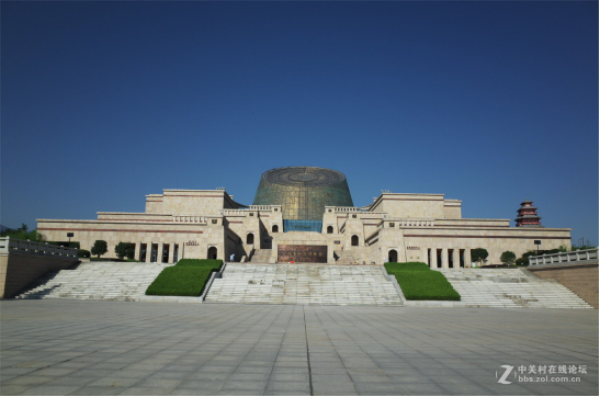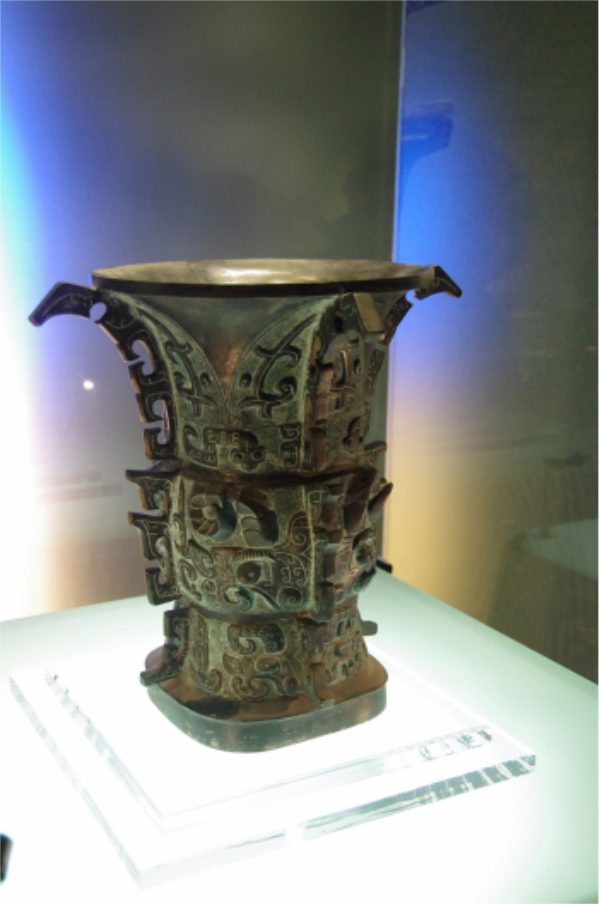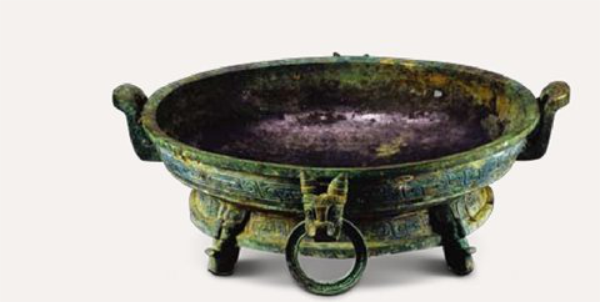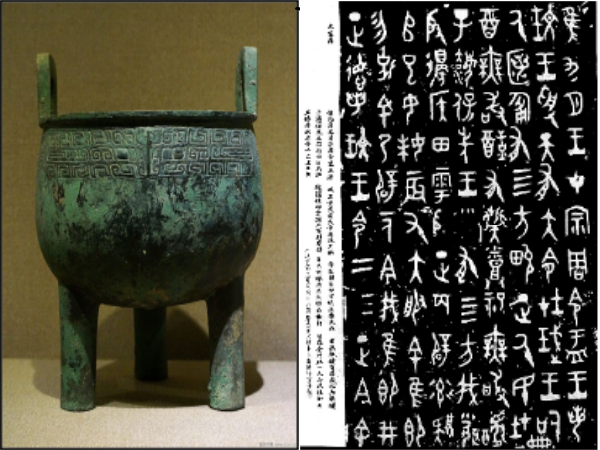Home to Bronze Ware

Baoji Bronze Ware Museum
Bronze ware refers to the vessels made of the alloy of cuprum, stannum and plumbum which are generally grayish green in color. Bronze ware appeared in China some 4,000 years ago and entered its prime in the Western Zhou Dynasty. As the seat of the capitals of the Western Zhou Dynasty and the Eastern Zhou Dynasty, Shaanxi was home to bronze vessels produced in the Western Zhou Dynasty. Up to now, about 20,000 bronze vessels have been excavated in China, among which approximately 10,000 pieces were dug out in Shaanxi and most of them were produced during the Western Zhou Dynasty. Bronze vessels of the Western Zhou Dynasty excavated in Shaanxi are mostly exquisite and unique in manufacturing technique, which won Shaanxi the accolade of “Home to Bronze Ware”. Recently, most bronze vessels unearthed in Shaanxi are collected by Shaanxi Historic Museum and Baoji Bronze Ware Museum.
Most bronze vessels were excavated from Guanzhong Area, particularly in the political center of the Western Zhou Dynasty, Zhouyuan, the joint capital of Feng and Hao and those nearby places producing the largest number of bronze ware. Moreover, most of the vessels were stored in special caches. Generally, a cache houses several pieces or even dozens of vessels. In 1960, for instance, the cache in Qijia Village, Fufeng County revealed 39 vessels. The cache in Zhangjiapo, Chang’an District, Xi’an City revealed 53 vessels. The Nanwei Family cache in Baijia Village, Fufeng County revealed as many as 103 pieces in one batch. Current excavation of the cache in Yangjia Village, Meixian County in 2003 revealed 27 vessels. Most of the vessels fell in different sets and were stacked together, but not all the vessels were produced at the same time. The owner of these vessels was possibly from a noble family and the cache was probably nearby a large construction complex. These vessels were stored in caches possibly because of the social upheavals in the late Western Zhou Dynasty. At that time, neighboring minorities attacked the capitals frequently and King Pingwang of Zhou Dynasty was forced to move the capital eastward to Luoyang and the nobles were forced to flee with him, thus the cumbersome bronze vessels being left behind and stored in underground caches by their noble owners.
Bronze vessels in the Western Zhou Dynasty are of various sorts and can be classified according to their functions into food utensils, liquor vessels, water holders, musical instruments, weapons and tools. Of them, food utensils, liquor vessels, water holders and musical instruments are most important bronze ware for they are mostly used for sacrificial ceremonies, such as showing worship to gods and ancestors, or are used in rites or ceremonies. Therefore they are called ritual utensils. Nobles of different ranks strictly complied with the regulations and restrictions on the number and types of vessels they could use for ceremonies. Vassals, for example, are not allowed to use the set of nine ding, a set which could only be exclusively used by the King, for rites or ceremonies, neither can dafu, a high-ranking official, use 7 at the same time, or else they will be considered “immoral”, “overstepping their due social status” or even “against the superiors” and consequently incurred reprimand or even severe punishment. Bronze ware, under such a system, became the symbol of social status or official position.
Legend has that the legendary figure Yu cast nine ding to symbolize jiuzhou (nine states of China) or China, and henceforward a set of nine ding became symbol of national sovereignty for generations. Therefore the existence of ding means the existence of a nation. This explains why there are such sayings in ancient books as “the last ruler Jie of the Xia Dynasty was incapable and therefore lost ding to Shang” and “King Zhouwang of Shang lost ding to Zhou for his extreme cruelty”.
gui is a food holder like the bowl we use nowadays. Tables and chairs had not yet appeared in the Western Zhou Dynasty and people used to sit on the carpet for meals. gui at that time was placed on the carpet for people to grasp food from it, and such eating habit can still be found in some minorities in China. In the Western Zhou Dynasty, gui was the second important ritual utensil apart from ding and was generally used in even number together with ding in odd number. The King of Zhou, who ranked top of the hierarchical system, used nine ding and eight gui while officials at the bottom of the rank can only use three ding and two gui for ceremonies. This principle on the use of ding and gui is called “the Ritual System for the Use of ding”.
Common liquor vessels include drinking vessels such as jue, gong and liquor holders like the kettle, zun, lei and you etc. During sacrificial ceremonies, wizards used liquor to drive people into wild illusion, so they would visualize such fantastic images as the ancestors or gods. Therefore, liquor was regarded as a mysterious liquid to connect people with gods or their ancestors in heaven. Consequently, the liquor holders took the leading position among all the ritual utensils. The King of Shang lost himself to liquor and was defeated, therefore after the founding of the Western Zhou Dynasty, Zhougong issued the Admonition against Liquor to prohibit the Zhou People from drinking alcohol. That’s why the liquor utensils were gradually replaced by cooking utensils as the major ritual utensils in the Western Zhou Dynasty.

Hezun—the first bronze ware bearing records about chronology in the early Western Zhou Dynasty
Water holders include yi, he and the plate. Since the bowl and chopsticks were not yet invented in the Western Zhou Dynasty, nobles preferred to take food with their hands when dinning. To show their piety and out of hygienic concern, people set it as a general rite to wash hands before meals. When practicing the rite, one person poured water from yi or he and another would use a plate to hold the falling water. Ancients believed that running water was better for washing hands, which is consistent with the modern hygienic concept.
Musical instruments are generally percussion instruments, including the bell, nao (cymbals) and chunyu, of which the bell is most important. Bells of various sizes were generally used in combination. The bigger bells produced low and heavy sound while the smaller ones high and crisp pitch. Bronze nao and chunyu were usually used for battles and, together with drums, they would show the soldiers when to charge and when to withdraw. The ancient saying has that “charge when drums are beat and withdraw while hearing the metal sound”, in which the metal refers to nao and chunyu.
Bronze weapons generally fall into two categories: the weapons for active attacks such as ge, mao (spear), jian (sword) and the bow etc.; and the defense weapons including zhou (helmet) and jia (armor) etc. ge was the commonest weapon in the Western Zhou Dynasty which can be justified by the large quantities of Chinese characters containing the component of ge, such as fa (attack), wu (martial arts) and rong (military forces). Idioms relevant to battles and wars can also be found to comprise the character of ge, which also offer supporting evidence.
As the precious cultural relics, bronze vessels of the Western Zhou Dynasty have added value due to the inscription and patterns engraved on them.
Inscriptions on the vessels generally record the owner’s name and reasons for its forgery, such as for sacrificial purposes or admonition, for cooking purpose, as an award, as a legal document for land transference, a pledge, an evidence for slave transaction, a historic record for a noble family or even a story about a criminal case. Inscriptions may include as few as one or two characters or as many as dozens or even hundreds of words. Archeological data show that the inscriptions on the bronze vessels excavated in Shaanxi Province add up to thousands of characters, which have immeasurable cultural value and academic value for historic research. These inscriptions gain China an irreplaceable position in the world’s bronze culture.

Lai plate
Since paper was not yet invented in the Bronze Age and records on wood plates and silk had decayed through the long history, written words about that period are rarely preserved. All important historic books including Shangshu, Shijing and other classics during that period, though remaining preserved, were hand-copied through generations and had lost a lot, which makes it impossible for recent researchers to have a clear view of the Bronze Age. Bronze vessels, however, came to the rescue for the inscriptions on them, with the long paragraphs of inscriptions in particular, illustrate the life style of that age. These evidences were preserved intact and were not modified by later generations. Because of their great value for academic research, these inscriptions win the accolade “the Bronze Historic Book”. Mao Gong ding excavated in Qishan County, Baoji City, for instance, bears a paragraph of 497 characters in 82 lines, which is the longest inscription found on bronze vessels till recently. Its value was highly praised as “Equaling to one chapter of Shangshu, an important book of history”. He zun, excavated in Baoji in 1963, is regarded as a national treasure for it was forged during the founding years of the Western Zhou Dynasty and is therefore the oldest bronze vessel carved with inscriptions. The 122-character inscription records the important event of Zhougong taking the throne and assisting King Chengwang in the establishment of the accompanying capital in Luoyang. Moreover, the expression “Zhongguo” (the hinterland of China) was used for the first time in recorded Chinese history. Wei ding excavated in Dongjia Village, Qishan County, Shaanxi in 1975 bears on its inner surface 207 characters, illustrating a legal case about land ownership dispute, which help us learn the land ownership in the Western Zhou Dynasty. Duoyou ding excavated in Chang’an District, Xi’an city in 1980 has on its inner side 278 characters in 22 lines, recording the aggression of Xianyun minority and the resistance and counterattack of the Zhou People, including such details as the cause, time, location and scale of the battle, which is of great importance for studies into the military affairs and relationship between Zhou and its neighboring ethnic groups. Excavation of the cache in Yangjia Village in 2003 revealed 27 bronze vessels of the late Western Zhou Dynasty which bore inscriptions of more than 4,000 characters, listing the 13 kings of the Western Zhou Dynasty and illustrating many historic events. These inscriptions further testified the records by the great historian Sima Qian. With an inscription of 310 characters the bronze lai Plate is regarded as the vessel with the longest inscriptions in about fifty years of archeological excavations.

Dayu ding and inscriptions on it
Ancient Chinese called bronze ware jin which literally means the bronze. Therefore, inscriptions on the bronze vessels were called jin wen, literally characters on bronze objects, which was the second mature writing system following jia gu wen, signs and carvings on tortoise shells and bones. Apart from the bronze vessels excavated in the Indus River Valley, vessels unearthed elsewhere generally have no inscriptions on them. Therefore, one major distinction between Chinese bronze vessels and vessels of other nations is whether there are inscriptions on them. In China, studies into the inscriptions on the bronze vessels originated in as early as the Song Dynasty, which caused the appearance of a discipline called epigraphy. Epigraphy was also regarded by some scholars as the origin of Chinese archeology. What is worth mentioning here is the initiator of epigraphy, Lv Dalin, was born in Lantian County, Shaanxi Province.
Chinese calligraphy is another gem of the Chinese traditional culture, which dates back to the epigraphy of the Western Zhou Dynasty. Epigraphy of the Western Zhou Dynasty shows the general components such as the various stokes of the traditional Chinese characters, which laid a solid basis for xiaozhuan (the seal script) and lishu (the official script) in the Han Dynasty.
Patterns on the bronze ware of the Western Zhou Dynasty generally fall into three categories: animal patterns, geographic patterns and patterns of human activities. Being decorative, they also embody rich cultural information. The patterns on bronze vessels of the early Western Zhou Dynasty, for instance, were greatly influenced by religious ideology at that time. Patterns of this period are similar to those of the Shang Dynasty, featuring animal images and imaginary animals such as taotie and kui dragon etc. Images about human activities were seldom found on vessels of this age. In terms of style, most patterns were gorgeous with exquisite structures. Most vessels were even covered with patterns of several types and some even have more than 20 designs on them. Weird patterns with complex supplementary veins make the ancient vessels all the more imposing and mysterious. Since the mid Western Zhou Dynasty, patterns on bronze ware had undergone remarkable changes with the complex and imposing patterns with mysterious looks like the taotie patterns being replaced by abstract and geometric patterns such as qiequ patterns, tile patterns and circles. In terms of structure, the traditional geometric patterns of beast faces which prevailed for centuries were replaced by free and continuous designs. These changes actually reflected the changes in ideology, which makes bronze ware valuable for not only the history of fine arts but also the history of ideology in China.
Since bronze vessels in ancient China were cast with pottery moulds and each pottery mould was used for merely one forgery, there were no two bronze vessels of the identical design and shape. This makes each bronze vessel a unique artwork with delicate design, gorgeous patterns and mostly unique inscriptions. The most exquisite ones are those zun which take the shape of birds or beasts with great vividness and delicate designs. Besides, many vessels, such as liquor vessels like jue, gu, jia and cooking vessels like ding, yan, xu etc. are Chinese specific and can seldom found in other countries. All in all, the exquisite and simple designs with Chinese specific patterns of taotie, kui dragon, the dragon, the phoenix and leiwei etc. make the bronze ware of the Western Zhou Dynasty stand out among the bronze vessels in the world.


